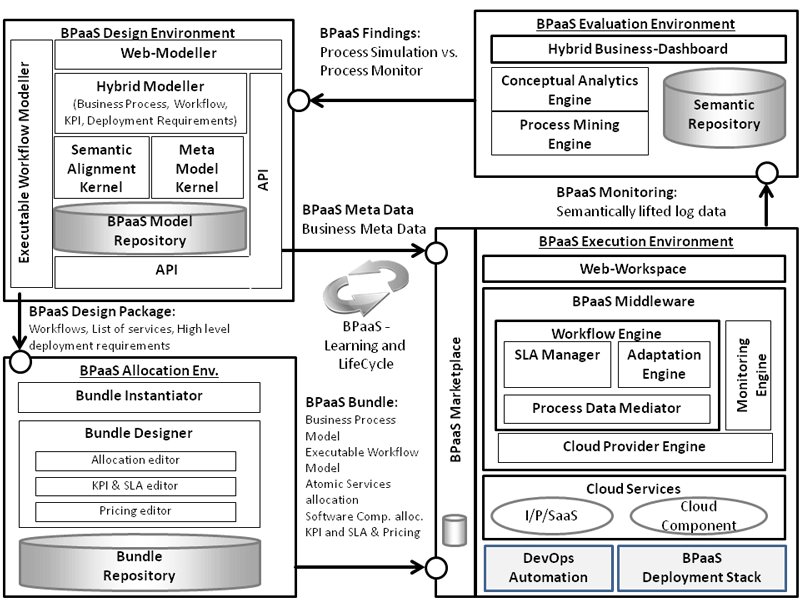by Kyriakos Kritikos and Dimitris Plexousakis (ICS-FORTH)
Many organisations are considering moving their business processes to the cloud to save money by also taking advantage of its infinite and affordable resources. However, this migration requires aligning the business and cloud levels as well as adaptively managing the business processes in the cloud. CloudSocket is a project dealing with these issues, which facilitates the transformation of business processes into business process as a service (BPaaS) products offered by organisations playing the role of a broker. A respective platform has been produced which enables the management of the whole lifecycle of a BPaaS.
In order to survive in a competitive and dynamic business world, organisations need to reduce costs and efficiently manage and scale their core and supporting business processes. As such, the cloud seems to be the right medium for deploying and adaptively provisioning these business processes. However, moving a business process in the cloud can be quite challenging. First, the business and IT levels must be aligned in such a way that the gap between business requirements and technical cloud-based capabilities can be bridged. Second, there is a need to appropriately manage an executable business process in the cloud such that it can be dynamically provisioned to guarantee the service level agreed with the customer.
CloudSocket is a H2020 project [L1] which aims to address these needs. It ambitions to support the role of the broker which has the ability to either offer BPaaS products in the market or consult potential customers on how they can migrate their business processes in the cloud. This project offers a BPaaS management platform [L2] that can deal with the whole lifecycle of a BPaaS, thus constituting the main instrument for realising the business of a broker. Such a platform comprises different environments which focus on different activities of the BPaaS lifecycle.

Figure 1: CloudSocket BPaaS management platform architecture.
The BPaaS Design Environment enables the broker to design business processes and map them to abstract workflows. This mapping is facilitated by two semantic approaches which also cater for the translation between business requirements and technical capabilities: (a) one [1] focusing on annotating business process activities and workflow fragments with ontological specifications to facilitate their alignment; (b) another focusing on a questionnaire-based approach which guides the user to provide the right answers in the pursuit of discovering cloud services that can realise the functionality of a business process.
The abstract workflow developed by the previous environment becomes concrete and deployable via the use of the BPaaS Allocation Environment. This environment is able to concretise the abstract workflow by selecting SaaS services that can realise workflow tasks as well as IaaS services to support the provisioning of the BPaaS workflow software components. This concretisation is facilitated by two complementary research approaches: (a) one [2] which relies on semantics and the concurrent selection of both IaaS and SaaS services to optimise the broker non-functional objectives; (b) another [3] which uses a DMN [L3]-based approach mapping decisions to quite technical description artefacts in the CAMEL [L4] language.
Deployable workflows are then offered in the form of a BPaaS bundle to potential customers via a Marketplace. Once such bundles are purchased by customers, they are deployed in the cloud and adaptively managed via the integration of three main components: (a) a Workflow Engine dealing with the workflow execution and management; (b) a cloud orchestration engine (Cloudiator [L5]) dealing with the cross-cloud workflow deployment; (c) a cross-layer service monitoring and adaptation framework.
Finally, the lifecycle loop is closed via the BPaaS Evaluation Environment which attempts to offer various types of analysis over the BPaaS performance to produce added-value knowledge that can be used to optimise the BPaaS. This environment relies on a semantic approach which integrates and semantically lifts information coming from the three components in the BPaaS Execution Environment into a Semantic Knowledge Base (SKB) and adopts a transformation approach to map high-level descriptions of KPIs to SPARQL [L6] queries to be assessed over the SKB so as to support KPI evaluation and drill-down.
Links:
[L1] https://www.cloudsocket.eu/
[L2] https://www.cloudsocket.eu/download
[L3] http://www.omg.org/spec/DMN/
[L4] http://camel-dsl.org/
[L5] https://github.com/cloudiator/
[L6] https://www.w3.org/TR/rdf-sparql-query/
References:
[1] K. Hinkelmann, et al.: “A Modelling Environment for Business Process as a Service”, in CAiSE, Springer, 2016.
[2] K. Kritikos, D. Plexousakis: “Multi-Cloud Application Design through Cloud Service Composition”, In Cloud, 686-693, 2015.
[3] F. Griesinger, et al.: “A DMN-based Approach for Dynamic Deployment Modelling of Cloud Applications”, in International Workshop on Cloud Adoption and Migration (CloudWays) at ESOCC, 2016.
Please contact:
Kyriakos Kritikos and Dimitris Plexousakis
ICS-FORTH, Greece
{kritikos,dp}@ics.forth.gr











